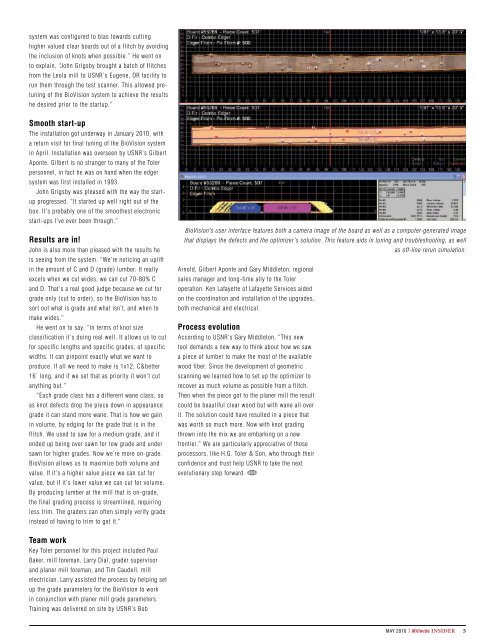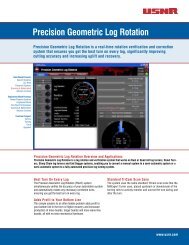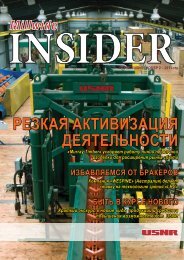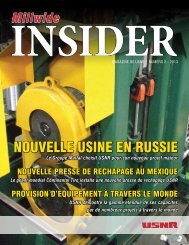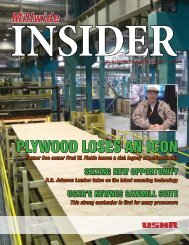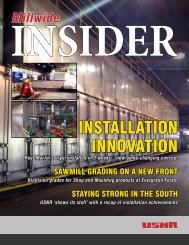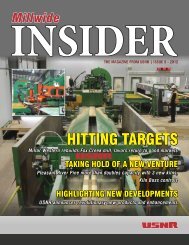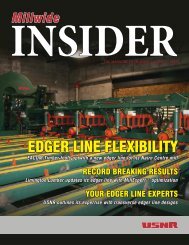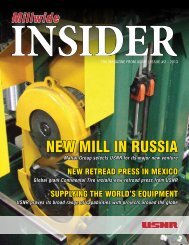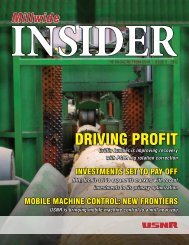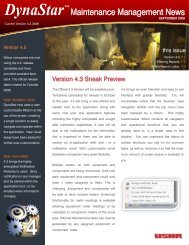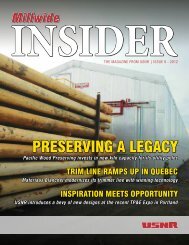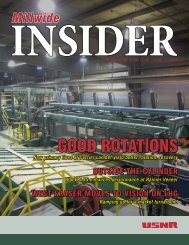Create successful ePaper yourself
Turn your PDF publications into a flip-book with our unique Google optimized e-Paper software.
system was configured to bias towards cuttinghigher valued clear boards out of a flitch by avoiding<strong>the</strong> inclusion of knots when possible.” He went onto explain, “John Grigsby brought a batch of flitchesfrom <strong>the</strong> Leola mill to <strong>USNR</strong>’s Eugene, OR facility torun <strong>the</strong>m through <strong>the</strong> test scanner. This allowed pretuningof <strong>the</strong> BioVision system to achieve <strong>the</strong> resultshe desired prior to <strong>the</strong> startup.”Smooth start-upThe installation got underway in January 2010, witha return visit for final tuning of <strong>the</strong> BioVision systemin April. Installation was overseen by <strong>USNR</strong>’s GilbertAponte. Gilbert is no stranger to many of <strong>the</strong> Tolerpersonnel, in fact he was on hand when <strong>the</strong> <strong>edge</strong>rsystem was first installed in 1993.John Grigsby was pleased with <strong>the</strong> way <strong>the</strong> startupprogressed. “It started up well right out of <strong>the</strong>box. It’s probably one of <strong>the</strong> smoo<strong>the</strong>st electronicstart-ups I’ve ever been through.”Results are in!John is also more than pleased with <strong>the</strong> results heis seeing from <strong>the</strong> system. “We’re noticing an upliftin <strong>the</strong> amount of C and D (grade) lumber. It reallyexcels when we cut wides, we can cut 70-80% Cand D. That’s a real good judge because we cut forgrade only (cut to order), so <strong>the</strong> BioVision has tosort out what is grade and what isn’t, and when tomake wides.”He went on to say, “In terms of knot sizeclassification it’s doing real well. It allows us to cutfor specific lengths and specific grades, of specificwidths. It can pinpoint exactly what we want toproduce. If all we need to make is 1x12, C&better16’ long, and if we set that as priority it won’t cutanything but.”“Each grade class has a different wane class, soas knot defects drop <strong>the</strong> piece down in appearancegrade it can stand more wane. That is how we gainin volume, by edging for <strong>the</strong> grade that is in <strong>the</strong>flitch. We used to saw for a medium grade, and itended up being over sawn for low grade and undersawn for higher grades. Now we’re more on-grade.BioVision allows us to maximize both volume andvalue. If it’s a higher value piece we can cut forvalue, but if it’s lower value we can cut for volume.By producing lumber at <strong>the</strong> mill that is on-grade,<strong>the</strong> final grading process is streamlined, requiringless trim. The graders can often simply verify gradeinstead of having to trim to get it.”BioVision’s user interface features both a camera image of <strong>the</strong> board as well as a computer-generated imagethat displays <strong>the</strong> defects and <strong>the</strong> optimizer’s solution. This feature aids in tuning and troubleshooting, as wellArnold, Gilbert Aponte and Gary Middleton, regionalsales manager and long-time ally to <strong>the</strong> Toleroperation. Ken Lafayette of Lafayette Services aidedon <strong>the</strong> coordination and installation of <strong>the</strong> upgrades,both mechanical and electrical.Process evolutionAccording to <strong>USNR</strong>’s Gary Middleton, “This newtool demands a new way to think about how we sawa piece of lumber to make <strong>the</strong> most of <strong>the</strong> availablewood fiber. Since <strong>the</strong> development of geometricscanning we learned how to set up <strong>the</strong> optimizer torecover as much volume as possible from a flitch.Then when <strong>the</strong> piece got to <strong>the</strong> planer mill <strong>the</strong> resultcould be beautiful clear wood but with wane all overit. The solution could have resulted in a piece thatwas worth so much more. Now with knot gradingthrown into <strong>the</strong> mix we are embarking on a newfrontier.” We are particularly appreciative of thoseprocessors, like H.G. Toler & Son, who through <strong>the</strong>irconfidence and trust help <strong>USNR</strong> to take <strong>the</strong> nextevolutionary step forward.as off-line rerun simulation.Team workKey Toler personnel for this project included PaulBaker, mill foreman, Larry Dial, grader supervisorand planer mill foreman, and Tim Caudell, millelectrician. Larry assisted <strong>the</strong> process by helping setup <strong>the</strong> grade parameters for <strong>the</strong> BioVision to workin conjunction with planer mill grade parameters.Training was delivered on site by <strong>USNR</strong>’s BobMAY 2010 | Millwide INSIDER


